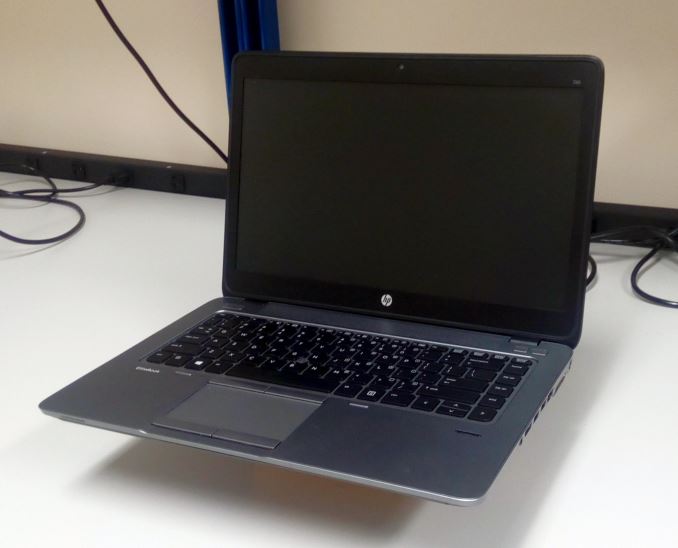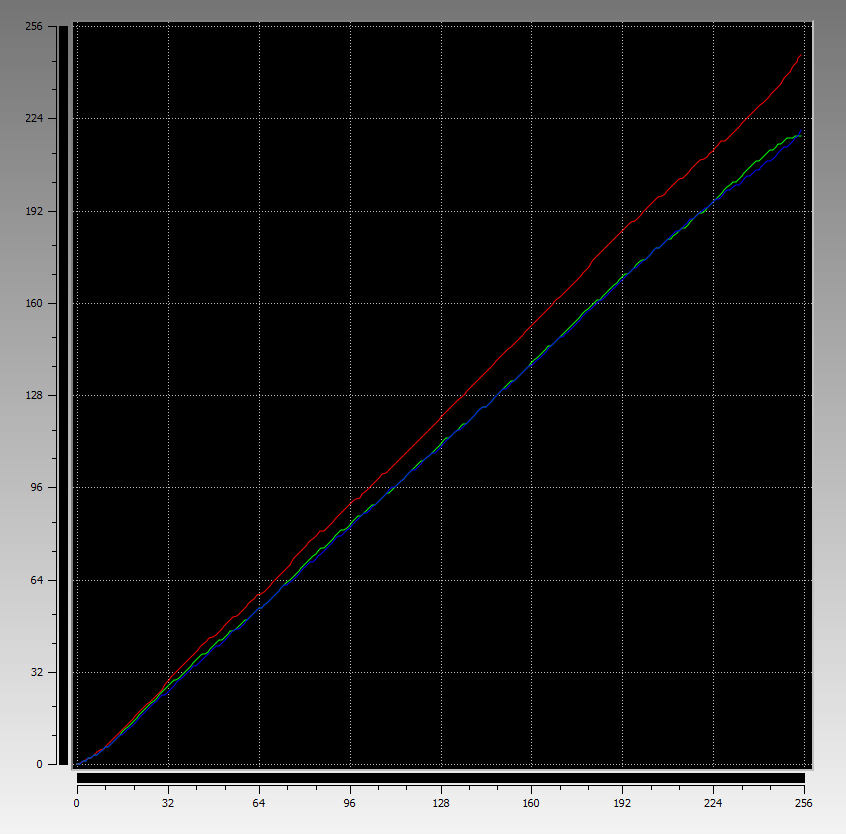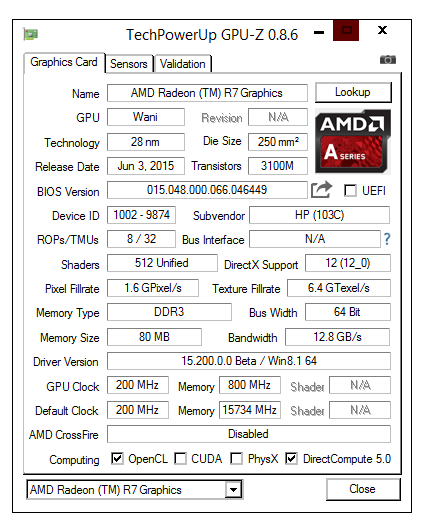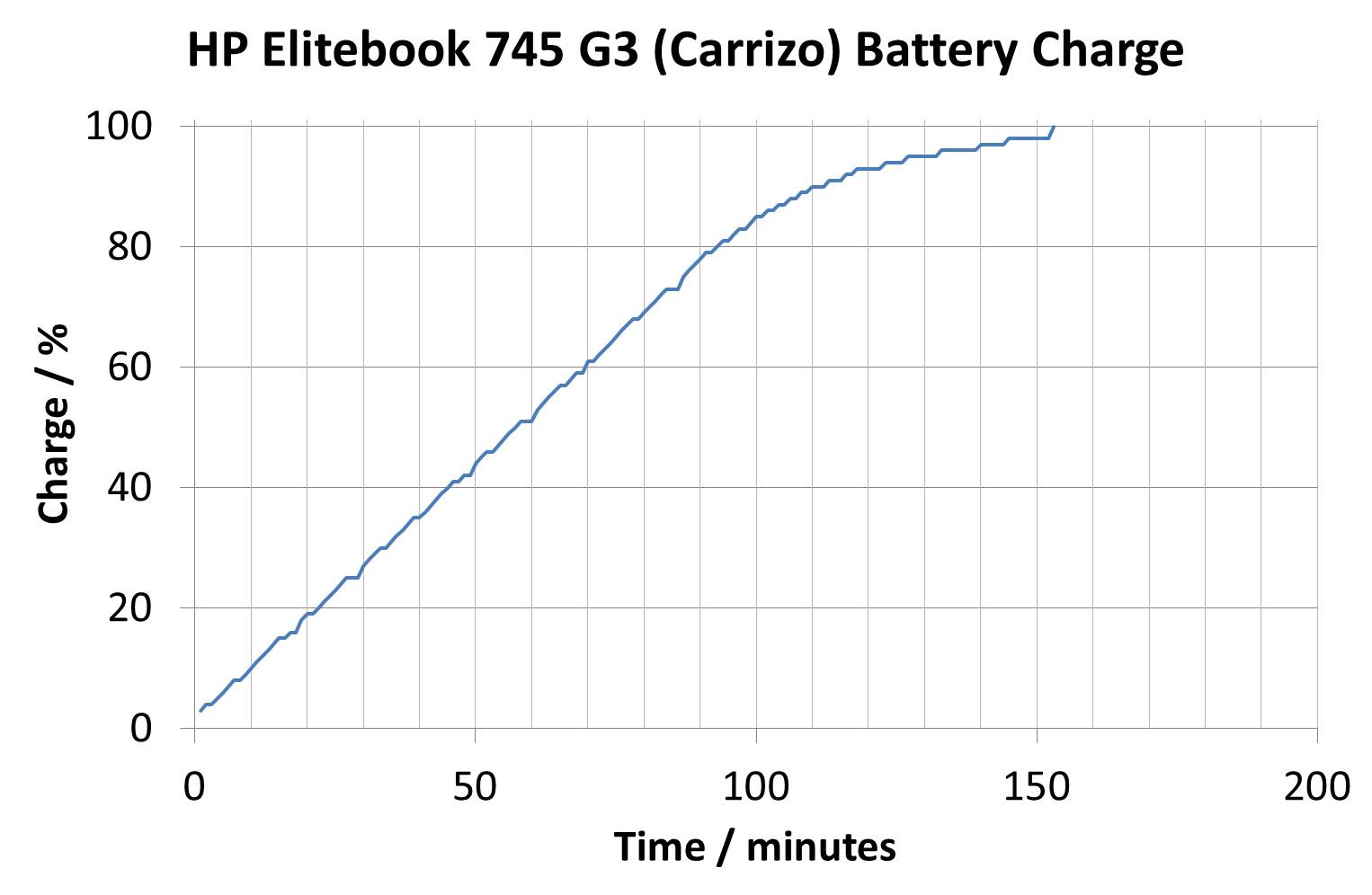Who Controls the User Experience? AMD’s Carrizo Thoroughly Tested
by Ian Cutress on February 4, 2016 8:00 AM EST#2 The HP Elitebook 745 G3 (Carrizo, PRO A12-8800B)
The Carrizo Elitebook 745 G3 looks practically identical to the Kaveri based 745 G2, so there’s no need to cover the visuals again, but the internals here cause a lot of talking points.
| HP Elitebook 745 G3 (Carrizo) Specifications | |
| Size and Resolution | 14-inch, 2560x1440 IPS |
| Processor | AMD PRO A12-8800B Dual module, 4 threads 2.1 GHz Base Frequency 3.4 GHz Turbo Frequency |
| Graphics | Integrated R7 512 Shader Cores 800 MHz maximum frequency GCN 1.2 |
| TDP | 15W |
| Memory | 4 GB in Single Channel Operation 1 x 4GB at DDR3L-1600 C11 2 SO-DIMM Slots |
| Storage | 128GB SSD |
| Battery Size | 45.76 Wh 3 cell Li-Po design, rated to 8.5 hours |
| WiFi | Broadcom Broadcom BCM943228Z 802.11ac 2x2 |
| Optical Drive | No |
| Dimensions | 13.3 x 9.3 x 0.74 in (non-touch) 13.3 x 9.3 x 0.80 in (touch) |
| Weight | 3.41 lb (non-touch) 3.76 lb (touch) |
| Webcam | 1280x720 |
| Other Features | Gigabit Ethernet 4 x USB 3.0 DisplayPort VGA Smart Card Reader |
| Operating System | Windows 8.1 |
| Website Link | link |
The G3 is almost the top premium model Carrizo you can buy, coming in at nearly $1100 if you put up the cash for the top model, which includes as much memory and storage you can fit in. For our unit, it came in at a more modest $700 ($700 for the base model, this was more $1100), which is more in-line with what price point AMD originally expected the Carrizo platform to hit. This is the first notebook with AMD’s new A12 line of processors, with this one being the PRO A12-8800B. This is a 15W part running at a base frequency of 2.1 GHz with a turbo mode up to 3.4 GHz. Any mobile APU in the A12 category has a full complement of 512 streaming processors similar to the FX mobile parts or A10 desktop parts, and the A12 runs these at 800 MHz. Unfortunately this is slightly crippled by only having the equivalent of one memory module in play, a single 4GB DDR3L-1600 module. It is dual channel capable if another is installed.
One of the big plus points with this model is the display, in comparison to the dire one on the G2, but this probably explains the majority of the cost in this 745 G3. With a 2560x1440 IPS display running a high contrast ratio (1422), it did have the best display out of what we tested for this piece. This is matched by the Wi-Fi solution, which had Broadcom’s BCM943228Z module which is an 802.11ac module in the M.2 form factor. One of the general feelings I had from the engineers here is that laptop Wi-Fi will all migrate to M.2 eventually on the understanding of better power control and form factor.
G3 Specific Testing
The 2560x1440 display varied from 0.21 nits all the way up to 297, nearly reaching the 300 mark but resulting in a 1422 contrast ratio. The white point was high, marking it up at 6657K.
While the color accuracy calibration graph looks as if the red line is the one going off on its own, it is actually the red line that is most accurate – we’re expecting a straight line through (0,0), (32,32), (64,64) and so on and while the red line is below most of these points, it isn’t as low as the green or blue.
The CPU-Z outlay shows the new FP4 socket with Carrizo over Kaveri, as well as having the full 12 compute units with those 512 SPs in tow.
On the integrated graphics side, despite the R7 graphics in there, the important element is that memory bandwidth running at 12.8 GB/s due to the single channel memory in use. We can also see the GPU clock running at 200 MHz idle, lower than the Kaveri implementation, which has power benefits.
With the 745 G3 we were able to do a run down on our light battery test, as well as run through some charge numbers.





















175 Comments
View All Comments
yannigr2 - Friday, February 5, 2016 - link
The 845 doesn't have an iGPU. You threw away the chance to directly compare the color compression advantage of Carrizo's GPU in a very limited bandwidth scenario like this one by either removing one dimm from the Kaveri laptop or adding another one in one of the Carrizo laptops. I wouldn't ask why. Thanks for the article.FriendlyUser - Saturday, February 6, 2016 - link
Thank you for this extensive article. Many people seem to dismiss AMD CPUs today without actual data. I commend your efforts to examine all aspects of real systems. I'll be waiting for the data from 845 (which sound like a decent upgrade for a NAS...).Keep up the good work.
JMC2000 - Sunday, February 7, 2016 - link
This is something I've been interested in since AMD released the 845 (wasn't there a Phenom II-based Athlon 845? I know there was a Phenom II 845...). Shame that they chose not to release an A12/FX Carrizo APU, those 512 shaders could be nice...mczak - Friday, February 5, 2016 - link
I agree with that, it's _really_ missing results with dual channel. I understand why single-dimm configurations were tested, but at least two of the notebooks had the option to use dual channel, and even if it might be difficult to get preconfigured options with dual-channel, it's easily upgradeable - I'm also interested in what Carrizo can do as a chip, not only what it can do if sufficiently crippled by the OEM.(Not that I expect wonders with dual channel though, at least not at 15W where the graphics doesn't run with more than half the max clock anyway, but still...)
Ian Cutress - Friday, February 5, 2016 - link
On the chip side, we'll do a full breakdown of perf and IPC when we get our hands on the desktop version in Athlon X4 845. I'm hoping to get some R-Series too, and we can do DDR3 vs DDR4 on AMD as well. That might provide a better pure comparison which I know some users want to see. I do too :)bojblaz - Friday, February 5, 2016 - link
Excellent, excellent article. Lucid questions asked and answers pursued - we need more of this kind of journalism. I can't praise this enough.It would have been really interesting to see the results had you filled the second SODIMM on the laptops that supported dual channel? I assumed time constraints prevented you from doing so. Also any chance of going to the OEMs directly and asking them why they make the decisions they make?
Lolimaster - Friday, February 5, 2016 - link
That's like givin 5 tons of deadweight to pre-Raditz-Vegeta saga Goku. AMD, why even bother, release your products under Ruby brand or something...TheinsanegamerN - Thursday, February 11, 2016 - link
I second that. A proper 13 inch design with a 35 watt 8800p, none of this hybrid graphics stuff, and good battery life, would be an insta-buy. Or 14 or 15 inch. I just want something like my old lenovo e535, but smaller. It cant be THAT hard, can it?nfriedly - Sunday, February 7, 2016 - link
Agreed. This article was basically a long-winded way of saying "all current AMD laptops suck, and we aren't even sure how good they could be because *all* the OEMs half-assed their designs"I, for one, would be very interested in an AMD designed laptop.
Cryio - Sunday, February 7, 2016 - link
Apparently AMD wants to push 28 nm even farther with Bristol Ridge, maybe better binned chips and hopefully DDR4 support will provide a much needed boost.